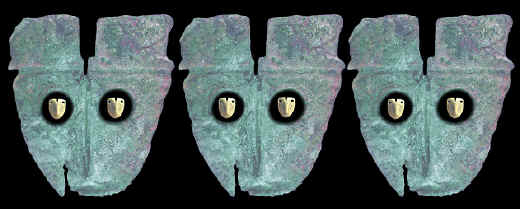|
"For many years rare examples of ear
ornaments called short-nosed and long-nosed god masks have been found in
various parts of the Mississippi Valley and in the southeast."---1996,
Gregory Perino, Central States Archaeological Journal, Vol. 33 No. 4.
"A human head (engraved on a shell cup from Spiro) portrays a
long-nosed god maskette as an ear ornament------. This "early"
Braden style rendering conforms to the description of He-who-wears-
human-heads-as-earrings, or Red Horn".---2000,
Diaz-Granados & Duncan, "The Petroglyphs of Missouri," p.
212.
"---the
long-nosed god maskettes may have functioned in the Early Mississippian
Period of the eastern United States within an adoption ritual much like
that of the Calumet ceremony of the historic period.----to create
fictions of kinship between the powerful leader of a large polity and
his political clients in outlying areas".---2004,
Timothy R. Pauketat "Ancient Cahokia and the Mississippians,"
p. 216.

LONG & SHORT NOSED GOD MASKS
MISSISSIPPI VALLEY & SOUTHEAST
U.S.
Long and short nosed god masks date to the Middle and Late Mississippian
period. They are most often found with burials and in positions that
suggest they were worn as ear ornaments. The majority of all known god masks have been
found on sites in Illinois, such as Dickson Mounds, Crable and Yokem.
|
|
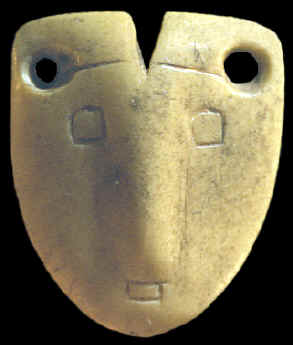
SHORT-NOSED BONE GOD MASK
ST. CLAIR COUNTY, ILLINOIS
This short nosed god mask was found several years ago by Larry
Kinsella. He found it in a cultivated field on a bluff top located
west of Belleville, Illinois in St. Clair County. He reported that
it was laying among plowed up human bones. This is the only known
god mask from this area that is made of bone.
This bone god mask is smaller than most copper
and shell god masks. It's basic outline, a
straight line across the forehead and a bi-lobed headdress are
similar features that compare to other masks. It differs slightly with the shape
of the eyes and mouth. Most god masks have round eyes and a
horizontal line for a mouth. This example has square eyes and an
rectangular mouth. This god mask also has two conically drilled
holes on each side of the forehead that would have been used for
suspension. It measures 15/16 of an inch (2.4 cm) long.
It's been suggested that this god mask may have
been a poor mans version. Most god masks were made of copper and shell,
materials that originate from distant locations. But since bone and
wood do not survive very long, it's possible more god masks were
actually made of these more common materials.
Note: The above image is a picture of a cast. The
original was lost many years ago. The picture in the
"Central States Archaeological Journal" is also a cast. Luckily,
it was molded just after it was discovered and casts were made for
future study. |
|
|
The most
interesting aspect about god mask ear ornaments are their possible
connection to the Winnebago legend of Red Horn. This legendary figure is
also known as Morning Star, He-who-wears-human- heads-as-earrings and
He-who-is-hit-with-deer-lungs.
The Winnebago oral history describes this person as an individual who
defeats giants in a ballgame. As the story continues it comes full
circle with the death of Red Horn, by a giant, but later he is magically
brought back to life by his two sons.
|
|
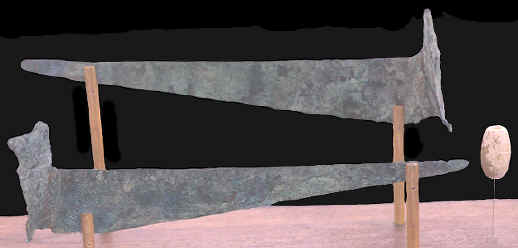
LONG-NOSED COPPER
GOD MASKS
CALHOUN COUNTY, ILLINOIS
Both of these long-nosed copper god masks were found several years
ago by William Fecht in a mound near Meppen, Illinois in Calhoun
County. He claimed to have found them in association with a burial.
They are the largest copper god masks found to date and the largest
of any long-nosed god masks found so far. It is believed they would
have been suspended from the ears of the individual. They measure
8
13/16 inches (22.4 cm) and 8 5/8 inches (22 cm) long. The large
shell bead to the right was also reported to have been found with
these copper ornaments.
Next to shell, copper is the second most
commonly reported material from which god masks were made. These two
god masks were made from natural copper nuggets from the Great Lakes
region. Each mask was assembled from two hammered and shaped sheets
of copper. One piece was fashioned into a long nose and the other
the face. Copper god masks have been found in Florida, Missouri,
Oklahoma, Louisiana and Wisconsin. |
|
|
Most god masks
were made of shell. The next most common material was copper. The two
copper examples illustrated here were dug from a mound in Calhoun
County, Illinois by William G. Fecht. They are the largest examples
found to date, measuring 8 13/16 inches (22.4 cm) and 8 5/8 inches (22
cm) long. The rarest materials are bone and wood. The short nosed god
mask illustrated in this article is made of bone. It was found several
years ago in a cultivated field by Larry Kinsella. He found it laying
among plowed up human bones. A short-nosed god mask made of wood was
reported by Griffin and Morse in 1961 to have been found in the Central
Illinois River Valley.
|
|
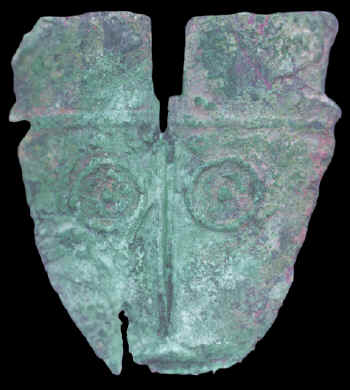
CLICK ON PICTURE FOR LARGER IMAGE
LONG-NOSED COPPER
GOD MASK
CALHOUN COUNTY, ILLINOIS
This picture shows the back of one of the copper long-nosed god
masks from Meppen, Illinois. The long nose extends outward on the
opposite side. The facial features are typical of most god masks.
There is a bi-lobed headdress, a horizontal line across the
forehead, two large round eyes and a straight line for a mouth.
"It may be suggested that the two
knobs on the head represent the castellated headdress or hair. Such
a double topknot is a common hairstyle for many Mississippian
figurines" (Emerson: 1982). The eyes are a noticeable
"stand-out" features on most god masks. They are usually
large and round and have pupils in the center and sometimes a double
circle. In Winnebago mythology these small masks are described
as "little faces with winking eyes. (Reilly III: 2004). |
|
|
So far, there
have been at least 21 recorded finds of long and short nosed god masks
from ten different states. The majority of them have been recovered on
Mississippian sites in Illinois. They have been found in Wisconsin,
Iowa, Missouri, Oklahoma, Arkansas, Tennessee, Louisiana, Alabama and as
far away as Florida.
|
|
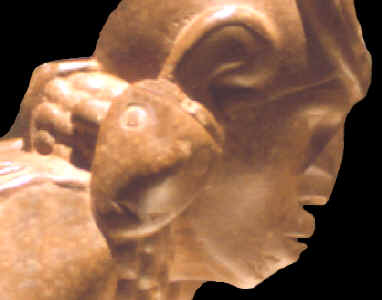
GOD MASK EAR
ORNAMENT ON "BIG BOY" PIPE
SPIRO MOUNDS SITE
LE FLORE COUNTY, OKLAHOMA
UNIVERSITY OF
ARKANSAS COLLECTION
God masks were worn as ear ornaments. Evidence of this comes from
artifacts like the
"Big
Boy" pipe from Spiro Mounds. The above picture shows
a god mask that was sculpted onto the ear of this human figure. This
ornamentation represents one of the reasons why this pipe probably
represents the legendary figure known as Red Horn, Morning Star or
He-who-wears-human-heads-as-earrings. |
|
|
God masks
are rare but enough of them have been found to help archaeologists
interpret regional interactions between widely separated ancient populations. Imagery is
a fairly reliable way to identify close ties between ancient peoples,
along with other diverse items of trade. God mask images are very simple
in form but they convey a strong visual impression-----------from the
whimsical to the mysterious and even to looking like creepy disembodied ghostly spirits.
|
|
"REFERENCES"
1975,
Brown, Janes A. & Phillips, Philip, "Precolumbian Shell
Engravings, From the Craig Mound at Spiro, Oklahoma," Vol. 2, plate
17 "Eight Heads: No Two Alike."
1982, Emerson, Thomas E., "Mississippian Stone Images In
Illinois," pp.31-32.
1986, Perino, Gregory, "A Rare Short-Nosed God Mask,"
"Central States Archaeologial Journal," Vol. 33, No. 4, pp.
248-249.
2000, Diaz-Granados, Carl & Duncan, James R., "The
Petroglyphs and Pictographs of Missouri," pp. 212-213 & 231-235.
2004, Pauketat, Timothy R., "Ancient Cahokia and the
Mississippians," pp. 170, 172, 114-116 & 118.
2004, Reilly III, F. Kent & Townsend, Richard F., "Hero,
Hawk, and Open Hand," "People of Earth, People of Sky,"
pp. 132-133 & 147-148.
|
|
RECENT
LISTINGS HOME
ORDERING |

